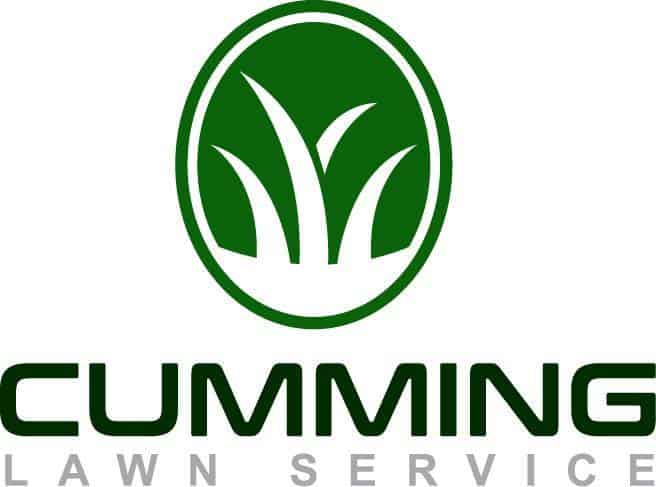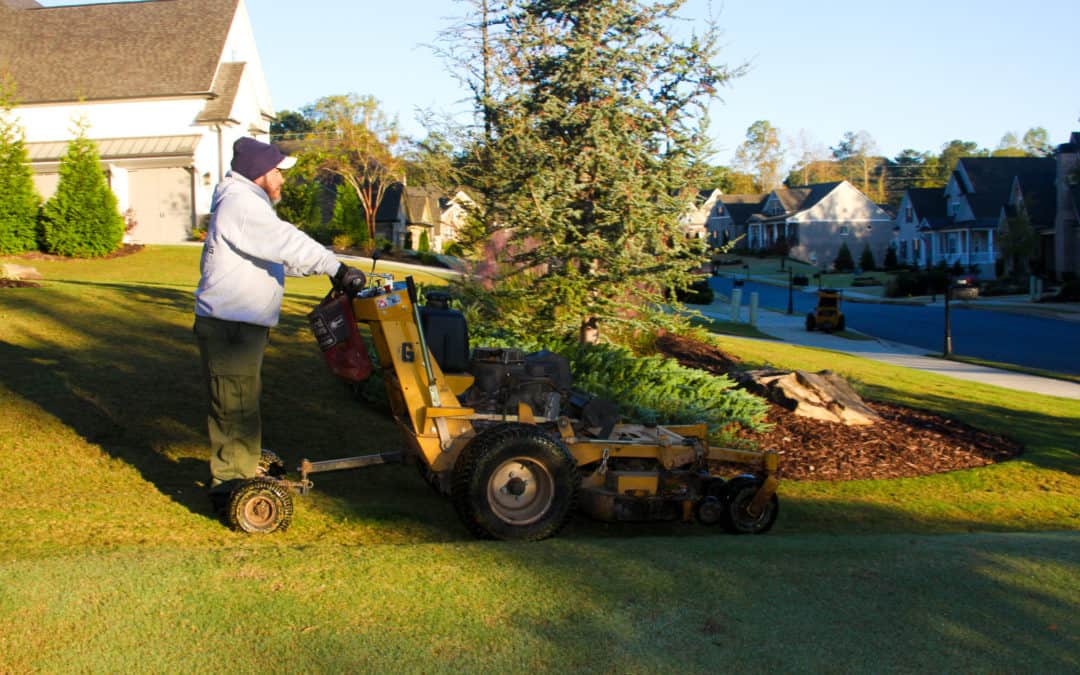All topics below is based on most popular varieties for Cumming Alpharetta and Milton Georgia
Proper Mowing
Proper mowing is a very important part of a healthy lawn. At Cumming Lawn Service, we recommend no more than every 7 days apart in mowing your lawn. With Bermuda and Zoysia if you can mow more frequently it will help with discoloration later in the summer. It is also very import that your blades are sharp. We sharpen the blades on all out mowers every 7 days with each crew mowing a full route. This is probably a max amount to spread sharpening out this far. The better you can keep your blades sharper the healthier your lawn will be. It is easy to tell by looking close at a blade of grass if it has been ripped or cut. As a general rule you don’t want to remove anymore than 1/3 of the blade when mowing. If you are mowing your own lawn the frequency by this rule is best practice. Bermuda and Zoysia can be kept shorter than Fescue. We usually start Bermuda around and 1 to 1 ½ as is shows signs of discoloration we raise ¼ inch topping out in late summer at 2 ½ inches, Zoysia we keep regularly at 2 to 2 inches. Cool season grass Fescue is a tall turf type grass and needs be at a minimum of 3 inches. We do scalp the fescue down to 2 inches before seeding in fall, once the new seed grows in we keep a steady height of 3 inches and my allow height to 3 ½ to 4 inches in the summer months.
Two distinct types of mowers are available for mowing turf-grasses: rotary mowers and reel mowers. Rotary mowers are the most popular because of their low cost, easy maneuverability and simple maintenance. The mower blade cuts the grass blade on impact. It causes a degree of mutilation and injury to the leaf blade at the point of impact. Most rotary mowers cannot give a quality cut lower than 1 inch on most turfgrasses, or lower than 2 inches on zoysiagrass. However, they are versatile and work well on taller grasses and weeds, for mulching grass clippings, and for general trimming.
Reel mowing vs rotary mowing
Reel mowers are for highly maintained turf where appearance is important. Reel mowers cut with a scissor-like action to produce a very clean, even cut. They are used at cutting heights of 2 inches or less. Bermudagrass and zoysia grass are best cut with a reel mower.
The number of blades needed to produce a smooth uniform cut will depend on the mowing height. Generally, as the height is lowered, the greater the number of blades is required on the reel.
Sharpening reel mowers is difficult and can be left to a professional mower repair service. Reel-type mowers require a relatively smooth surface to obtain a quality cut. Using reel mowers on extremely uneven surfaces will result in scalped areas.
Maintaining a sharp cutting blade is as important with rotary mowers as with reel mowers. A dull blade will cause the leaf blade to turn brown at the point of impact and will give the lawn a general brown cast. Mow with a sharp mower blade. Sharp blades cut the grass cleanly, ensuring rapid healing and regrowth. When dull blades tear and bruise the leaves, the wounded grass plants become weakened and are less able to ward off invading weeds or to recover from disease and insect attacks.
Rotary mowers
Rotary mowers are the most popular because of their low cost, easy maneuverability, and simple maintenance. The mower blade cuts the grass blade on impact. It causes a degree of mutilation and injury to the leaf blade at the point of impact. Most rotary mowers cannot give a quality cut lower than 1 inch on most turfgrasses, or lower than 2 inches on zoysia grass. However, they are versatile and work well on taller grasses and weeds, for mulching grass clippings, and for general trimming.
A modification of rotary mowers is mulching mowers. These are designed to cut leaf blades into very small pieces that are able to fall into the lawn rather than remain on top of the grass. As these pieces are small, they decompose more quickly than blades cut to traditional size. The mower blades are designed to create a mild vacuum in the mower deck until the leaf blades are cut into these small pieces. Mulching mowers do not have the traditional discharge chute as do most rotary mowers.
Bagging
We at Cumming Lawn Service believe in grass cycling. “NOT BAGGING” if done properly it is possible to leave the nutrients that is in the blades of the grass to go back to the soil. With proper mowing, sharp blades and consistent mowing every 7 days mulching the lawn is very healthy for the lawn. The majority of the nutrients from the fertilize is in the top of the blade. So, bagging the grass removes the nutrients provided by the fertilize. If the lawn isn’t mown regularly, it would be recommended to bag the clippings. Also, in a severe drought situation where its necessary to raise the mowing height to 2 ¾ to 3 inches in the summer it may be needed to bag the lawn at the end of the season to lower the lawn back down or the next season when scalping. If the lawn is scalped at small proportions, we recommend allowing the clippings to rot away as the lawn gets watered. In the early spring at Cumming Lawn Service, we start in February taking ¼ inch off the Bermuda each visit a month to no less than 2 weeks apart until we have the dormant grass down to ½ to ¾ inch high. Then it is ready for green up. We believe this is the best practice for mowing your Bermuda lawn as far as bagging is concerned.
With Zoysia it isn’t necessary to scalp the lawn all the way down. We only take maybe ¼ to a ½ inch off Zoysia lawns, we try to keep the height at 2 to 2 ½ inches through out the summer. We follow the same
practices as far as bagging goes with Zoysia. We grass cycle and do not bag. It is very important as well with Zoysia to consistently mow every 7 days or less. Our schedules are set up on a 7 day rotation. This is very important with grass cycling. Again, if you end up at 9 to 10 days it would be best to bag either of these grasses. From Clemson University on grass cycling;
Return or recycle grass clippings to the lawn. Grass clippings contain about 4 percent nitrogen, one-half to 1 percent phosphorus, 2 to 3 percent potassium and smaller amounts of other essential plant nutrients — basically a 4-1-3 fertilizer. When left on the lawn, these nutrients are eventually returned to the soil.

